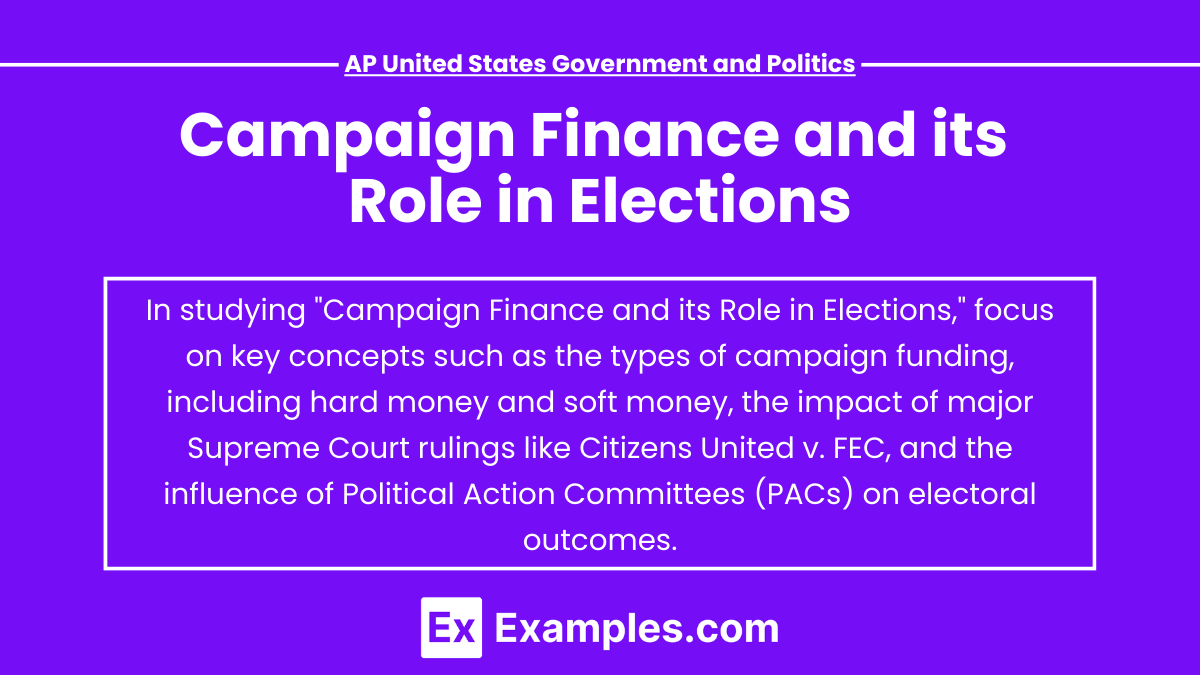Campaign finance plays a pivotal role in American elections, influencing how candidates fund their campaigns and shaping electoral outcomes. It encompasses various funding sources, including individual contributions, Political Action Committees (PACs), and Super PACs. Understanding the regulations surrounding hard and soft money is essential, especially in light of landmark Supreme Court cases like Citizens United v. FEC. The implications of campaign finance extend beyond candidates, affecting public policy, voter perceptions, and the overall integrity of the democratic process.
Free AP United States Government and Politics Practice Test
Learning Objectives
In studying "Campaign Finance and its Role in Elections" for the AP United States Government and Politics exam, you should aim to define what campaign finance is and understand its significance in the electoral process. Familiarize yourself with the different sources of campaign funding, including individual contributions, Political Action Committees (PACs), Super PACs, and party donations. Understand the distinction between hard money and soft money and how these concepts affect campaign financing. Evaluate the impact of major Supreme Court cases, particularly Citizens United v. FEC and Buckley v. Valeo, on campaign finance regulations. Analyze how campaign finance influences candidate behavior, public policy, and voter perceptions. Examine the role of dark money in elections and its implications for transparency and accountability in the political process. Understanding these elements will provide a comprehensive view of how campaign finance shapes American democracy.
1. Sources of Funding
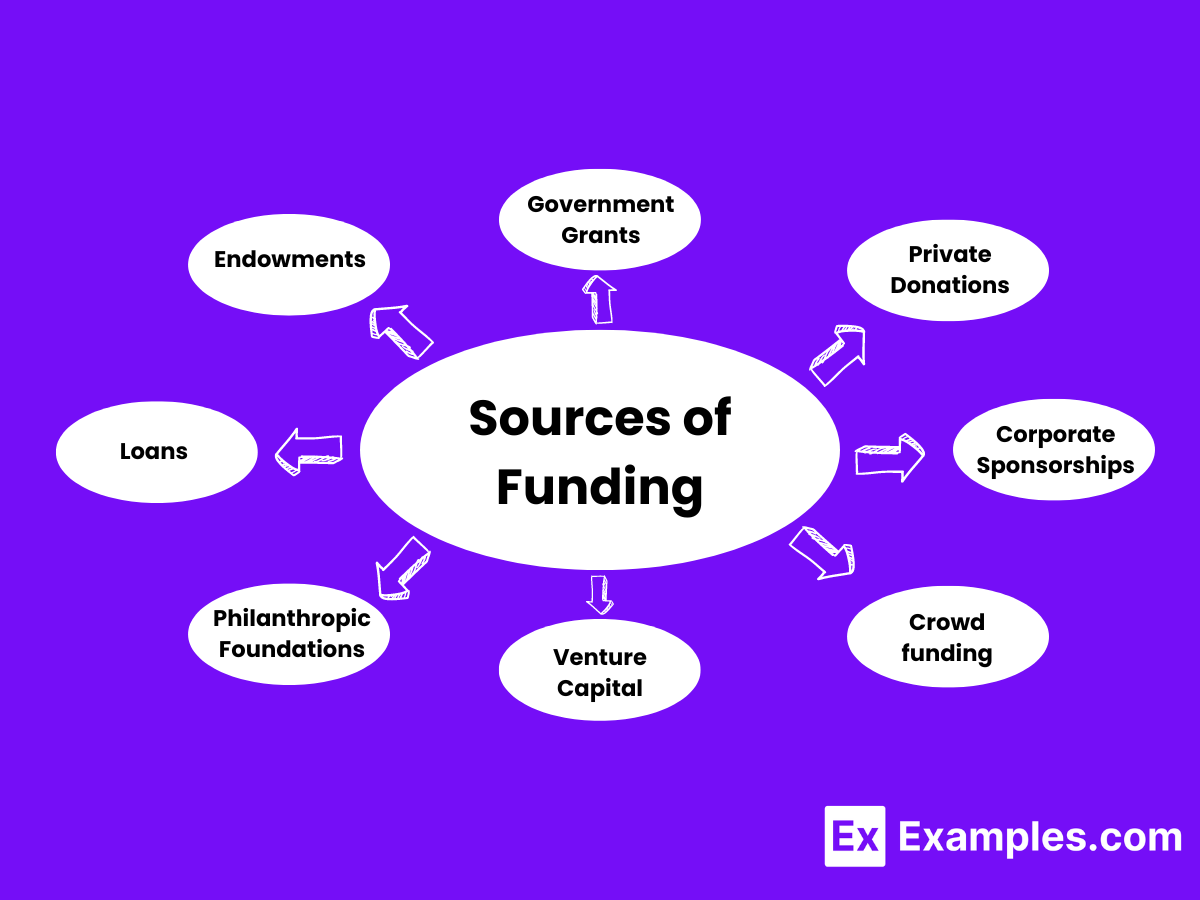
Campaign funding comes from multiple sources, including:
Government Grants
Financial support provided by federal, state, or local governments for specific projects, research, or initiatives.Private Donations
Contributions from individuals or families, often aimed at supporting nonprofit organizations or community projects.Corporate Sponsorships
Funding from businesses in exchange for brand visibility or partnership opportunities, often used for events or programs.Crowdfunding
Raising small amounts of money from a large number of people, typically via online platforms, to fund projects or ventures.Venture Capital
Investment from firms or individuals in startups and small businesses with high growth potential, often in exchange for equity.Philanthropic Foundations
Organizations that provide funding to support various causes, often focused on social issues, education, or health.Loans
Borrowed funds from banks or financial institutions that must be repaid over time with interest, used for business expansion or projects.Endowments
Funds that are invested to generate income for an organization, often used by universities or nonprofits to support ongoing operations.
2. Regulations
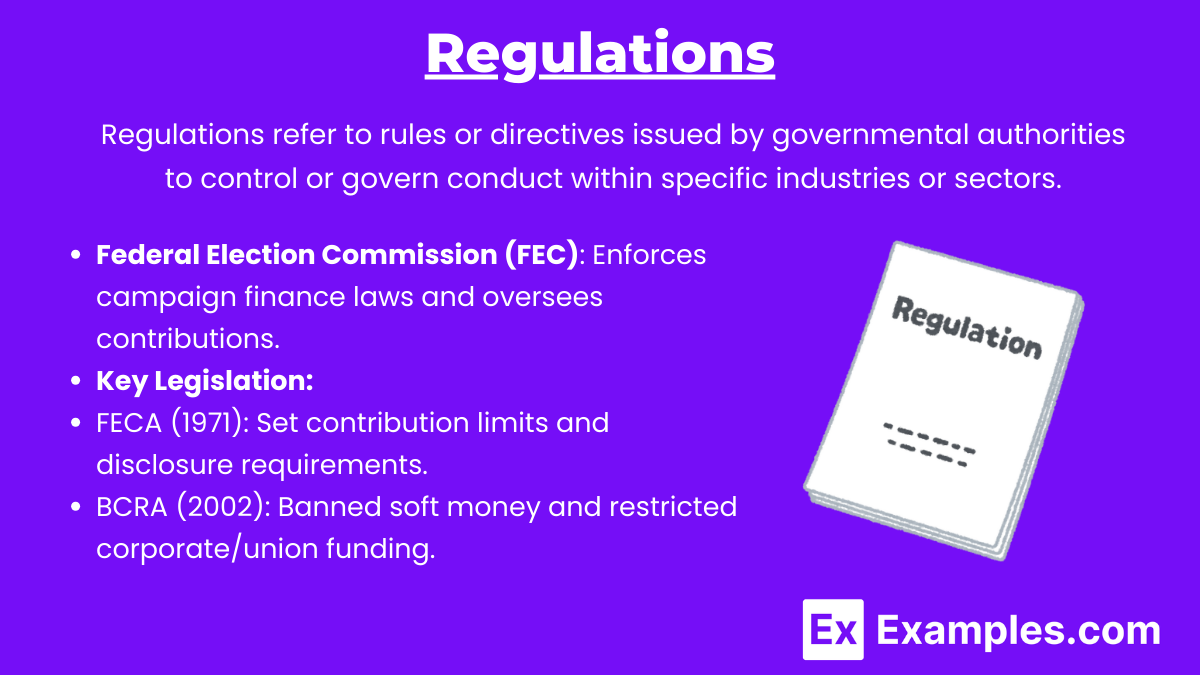
Regulations refer to rules or directives issued by governmental authorities to control or govern conduct within specific industries or sectors. They are designed to ensure compliance with laws, protect public interests, and maintain order by setting standards for behavior, safety, and operations.
Federal Election Commission (FEC): Established to enforce campaign finance laws, the FEC oversees the reporting of contributions and expenditures, ensuring compliance with limits and regulations.
Key Legislation:
Federal Election Campaign Act (FECA): Initially passed in 1971 and amended several times, FECA established disclosure requirements and contribution limits for federal candidates.
Bipartisan Campaign Reform Act (BCRA): Enacted in 2002, this law aimed to regulate the influence of money in politics by prohibiting soft money contributions to national parties and restricting the use of corporate and union funds for "electioneering communications."
Supreme Court Rulings:
Citizens United v. FEC (2010): A landmark decision that ruled that corporations and unions can spend unlimited amounts on independent political expenditures, effectively equating money with free speech. This ruling dramatically changed the campaign finance landscape, leading to the rise of Super PACs.
3. Impact on Elections
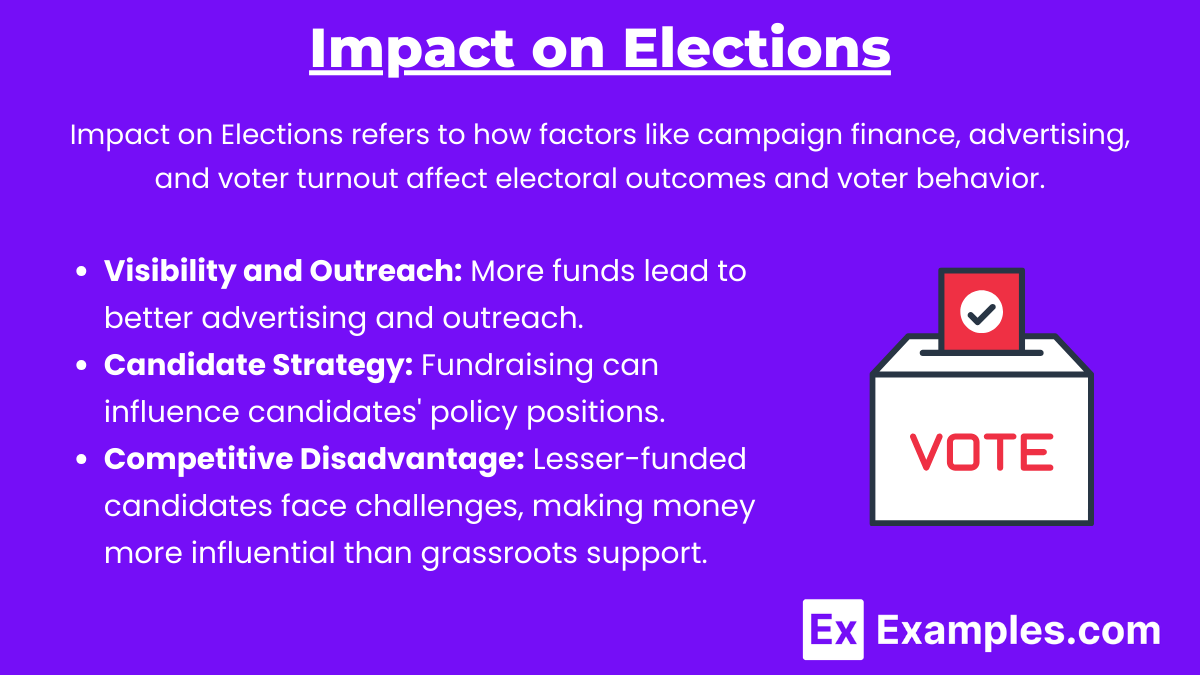
Impact on Elections refers to the effects that various factors, such as campaign finance laws, political advertising, voter turnout, and candidate platforms, have on the outcomes and dynamics of electoral processes. This includes how these factors influence voter behavior, the competitiveness of races, and the overall integrity of the electoral system.
Visibility and Outreach: Candidates with more financial resources can engage in extensive advertising, outreach, and mobilization efforts, increasing their chances of winning. Television ads, online marketing, and direct mail campaigns are common strategies used to reach voters.
Candidate Strategy: The need to raise funds can affect candidates' policy positions and priorities, as they may align their platforms with the interests of major donors or fundraising sources.
Competitive Disadvantage: Lesser-funded candidates often struggle to compete, leading to a political landscape where financial resources can overshadow grassroots support and popular appeal.
4. Public Funding
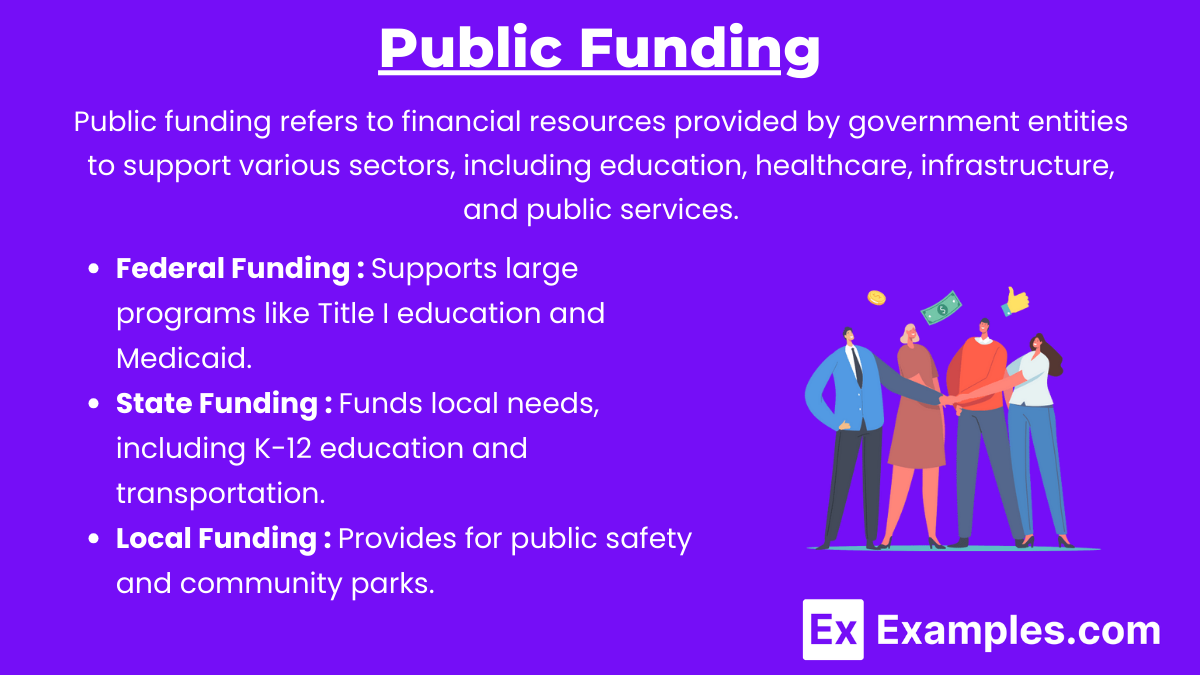
Public funding refers to financial resources provided by government entities to support various sectors, including education, healthcare, infrastructure, and public services. This funding plays a crucial role in ensuring that essential services are accessible to all citizens.
Federal Funding
Federal funding comes from the national government and is distributed to states and local governments. It often supports large-scale programs, such as:Education: Title I funding for low-income schools.
Healthcare: Medicaid and Medicare programs.
State Funding
States allocate funds for local needs, including:Public Schools: Funding for K-12 education and state universities.
Transportation: Maintenance and construction of roads and public transit systems.
Local Funding
Local governments, such as cities and counties, collect taxes and provide funding for community services, including:Public Safety: Funding for police and fire departments.
Parks and Recreation: Maintaining community parks and recreational facilities.
5. Voter Perception and Reform
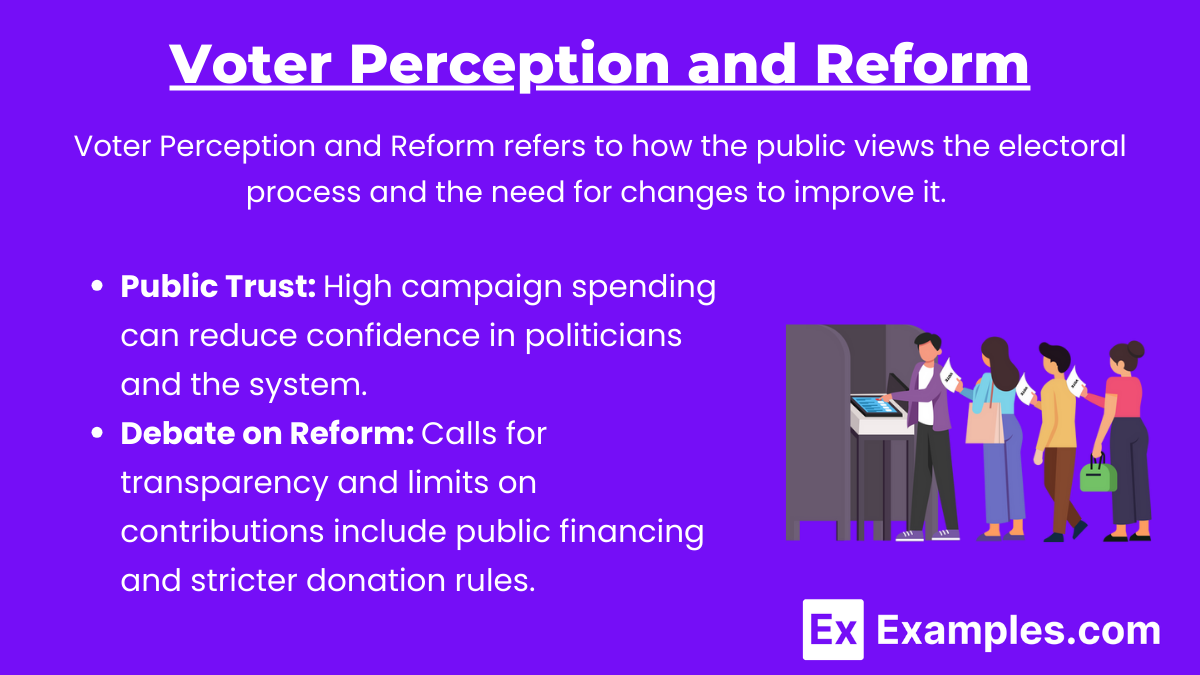
Voter Perception and Reform refers to how the public views the electoral process and the need for changes to improve it. This includes attitudes toward voting accessibility, fairness, and the effectiveness of current laws and policies. Reform aims to enhance voter trust and participation in elections.
Public Trust: High levels of campaign spending can lead to perceptions of corruption and influence peddling, undermining public confidence in elected officials and the political system.
Debate on Reform: Ongoing discussions about campaign finance reform focus on increasing transparency, limiting contributions, and addressing the influence of money in politics. Proposals include measures such as public financing for all candidates, stricter limits on donations, and enhanced disclosure requirements.
Examples
Example 1 : 2016 Presidential Election
The 2016 election showcased the significant influence of campaign finance, particularly through the use of Super PACs. Candidates like Donald Trump and Hillary Clinton raised hundreds of millions of dollars, with outside groups spending heavily on advertisements. For instance, the pro-Clinton Super PAC, Priorities USA Action, spent over $192 million on ads, significantly shaping voter perceptions and campaign narratives.
Example 2 : Citizens United v. FEC (2010)
This landmark Supreme Court decision fundamentally changed campaign finance by ruling that corporations and unions can spend unlimited amounts on independent political expenditures. This ruling led to a surge in the establishment of Super PACs, which can raise and spend unlimited funds, allowing wealthy individuals and organizations to have a greater impact on elections.
Example 3 : Bipartisan Campaign Reform Act (BCRA)
Enacted in 2002, the BCRA aimed to address issues of campaign finance by prohibiting soft money contributions to national political parties and placing limits on electioneering communications. Although parts of the law were struck down by the Supreme Court, it represented a significant effort to regulate the influence of money in politics and promote transparency.
Example 4 : California Proposition 30 (2012)
In California, Proposition 30 aimed to increase taxes to fund education and public safety. The campaign saw significant financial backing from education unions and progressive groups, which collectively raised over $37 million. Their successful campaign demonstrated how coordinated financial efforts can mobilize voters around specific policy issues, ultimately leading to the proposition's passage.
Example 5 : Influence of Dark Money
Dark money refers to political spending by nonprofit organizations that are not required to disclose their donors. In the 2018 midterm elections, it was estimated that approximately $174 million was spent by dark money groups, which significantly influenced races across the country. This anonymity raises concerns about accountability and the potential for undisclosed interests to sway electoral outcomes without public scrutiny.
Multiple Choice Questions
Question 1
Which Supreme Court case ruled that corporations and unions can spend unlimited amounts on independent political expenditures?
A) McCain-Feingold Act
B) Buckley v. Valeo
C) Citizens United v. FEC
D) Davis v. Federal Election Commission
Correct Answer: C) Citizens United v. FEC
Explanation: The 2010 Supreme Court ruling in Citizens United v. FEC determined that restrictions on independent expenditures by corporations and unions violate the First Amendment’s guarantee of free speech. This decision led to the rise of Super PACs, which can raise and spend unlimited amounts of money, fundamentally altering the campaign finance landscape.
Question 2
What is the primary purpose of the Bipartisan Campaign Reform Act (BCRA)?
A) To increase the amount of soft money contributions to political parties
B) To prohibit foreign contributions to U.S. elections
C) To regulate the influence of money in politics and increase transparency
D) To eliminate all forms of campaign financing
Correct Answer: C) To regulate the influence of money in politics and increase transparency
Explanation: The BCRA, enacted in 2002, aimed to address the issues of soft money and unregulated contributions. It prohibited soft money contributions to national political parties and set limits on electioneering communications, thus striving to reduce the influence of money in politics and enhance transparency in campaign financing.
Question 3
What does the term "dark money" refer to in the context of campaign finance?
A) Contributions made by candidates to their own campaigns
B) Funds raised by Super PACs that disclose their donors
C) Political spending by nonprofit organizations that do not disclose their donors
D) Government funding for political campaigns
Correct Answer: C) Political spending by nonprofit organizations that do not disclose their donors
Explanation: Dark money involves funds used in political campaigns by organizations that are not required to disclose their donors. This type of spending can obscure the source of financial influence in elections, raising concerns about accountability and the potential for undisclosed interests to sway political outcomes. In recent elections, dark money has played a significant role in shaping campaign narratives without transparency.

